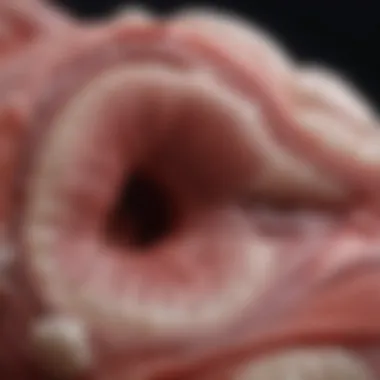Comprehensive Overview of Endocarditis Types and Management


Intro
Endocarditis is a significant medical condition that entails inflammation of the inner layer of the heart, known as the endocardium. Understanding this condition requires a deep dive into its types, underlying causes, symptoms, diagnostics, and management. This article intends to unpack these themes, providing a thorough examination for students, researchers, and healthcare professionals.
Key aspects to consider involve the myriad forms of endocarditis, which range from typical bacterial infections to rarer fungal infections. Each of these variations presents distinct clinical features that inform diagnosis and management approaches.
In light of the complexities surrounding this condition, the aim is to equip readers with the vital information required for better clinical practices, ultimately improving patient outcomes. Furthermore, it underlines the need for focused research to deepen understanding and enhance treatment methodologies.
Research Context
Background and Rationale
Endocarditis remains a serious complication in patients with pre-existing heart conditions or those who have undergone certain medical procedures. The increasing incidence of antibiotic-resistant bacteria further complicates this landscape, making it crucial to explore the various types of endocarditis and their unique challenges.
Literature Review
Several studies have documented the rise of infectious diseases, including endocarditis, attributed to changing demographics and advancements in medical procedures. Research illustrates that early detection and appropriate treatment can greatly influence clinical outcomes. Notably, a review highlighted the importance of rigorous diagnostic techniques to differentiate between the types of endocarditis, which can include native valve endocarditis and prosthetic valve endocarditis, among others.
"Thorough understanding of endocarditis types is key for effective treatment."
Through this literature, it becomes clear that a comprehensive examination is paramount to navigate the complexities surrounding endocarditis.
Methodology
Research Design
This article employs a qualitative approach, drawing from existing literature and clinical studies. This design enables a nuanced understanding of how various factors contribute to endocarditis, including pathogen types, patient demographics, and clinical practices.
Data Collection Methods
Data for this article has been sourced from peer-reviewed journals, clinical case reports, and recent guidelines on infectious diseases. These resources provide a well-rounded view of the current landscape of endocarditis management, shedding light on emerging trends and reinforcing traditional practices.
Intro to Endocarditis
Endocarditis is a complex and often serious infection of the inner lining of the heart chambers and valves. Understanding endocarditis is crucial for both clinical practice and academic research. The intricacies involved in diagnosing and treating this condition require a thorough grasp of different types, their causes, and their management strategies. This understanding can significantly improve patient outcomes and guide future research efforts in the field.
Definition and Overview
Endocarditis is defined as an inflammation of the endocardium, which is the inner layer of the heart. This condition most frequently occurs when bacteria or fungi enter the bloodstream and adhere to damaged heart tissue. The potential consequences of untreated endocarditis can be severe, ranging from valve destruction to systemic embolism. Commonly affected populations include those with pre-existing heart conditions, prosthetic devices, or a history of intravenous drug use. Recognizing the risk factors and symptoms associated with endocarditis is integral to timely diagnosis and intervention.
Historical Context
The history of endocarditis dates back to early medical literature, with its descriptions found in texts from the 19th century. This condition was not well understood initially and often resulted in a poor prognosis. Over decades, advances in microbiology and the development of antibiotics significantly changed the management of endocarditis. Notably, the introduction of penicillin in the 1940s marked a turning point in treatment options. Understanding the evolution of endocarditis helps contextualize current practices and informs future directions in research and management.
"The history of endocarditis reflects the broader advancements in medical science, illustrating how historical understanding can drive modern treatment methodologies."
In summary, the introduction to endocarditis sets the stage for a detailed exploration of the various types, causes, and management strategies for this condition. A clear understanding of its definition and historical significance provides the necessary foundation for further discussion.
Types of Endocarditis
Understanding the types of endocarditis is crucial for clinical practice and research. Each type presents unique characteristics, causes, and treatment responses. A precise identification aids in better management strategies and improved patient outcomes. The variation among types can significantly influence how healthcare providers approach diagnosis and therapy.
Acute Bacterial Endocarditis
Acute bacterial endocarditis is a severe and rapid form of endocarditis. It typically occurs in patients with pre-existing heart conditions. This type can lead to significant morbidity due to its aggressive nature.
Common pathogens involved
The common pathogens associated with acute bacterial endocarditis mainly include Staphylococcus aureus and Streptococcus pneumoniae. These bacteria are particularly notable for their virulence.
This is important because they can rapidly proliferate within the heart's inner lining, causing extensive damage. The key characteristic of these pathogens is their ability to adhere to damaged valves. This adherence is a critical step in the progression of the disease. The presence of these organisms leads to a higher risk of complications.
Clinical presentation and symptoms
Clinical presentation of acute bacterial endocarditis can be sudden and severe. Symptoms often include high fever, chills, and fatigue. Other symptoms may consist of heart murmurs or petechiae, small pinpoint bleeding under the skin. What stands out is the rapid deterioration in health, which can be alarming for patients and physicians alike. The unique feature of this type is how swiftly it can lead to systemic infections and organ failure. Understanding these presentations is vital for timely diagnosis.
Subacute Bacterial Endocarditis
Subacute bacterial endocarditis differs significantly from its acute counterpart. It typically has a slower progression, often occurring in patients with pre-existing heart conditions or abnormalities.


Characteristics distinguishing it from acute
The primary distinction lies in the speed of onset and severity of symptoms. Subacute bacterial endocarditis tends to evolve over weeks to months. Patients may have milder symptoms, which can lead to delayed diagnosis. This slower progression often allows the body to compensate better, potentially confusing the clinical picture. Importantly, this distinction affects treatment decisions and urgent care approaches.
Risk factors and predispositions
Certain risk factors predispose individuals to subacute bacterial endocarditis. Most notably, patients with pre-existing heart conditions, such as rheumatic heart disease, are at higher risk. The unique characteristic of this association underlines the importance of monitoring at-risk patients. Acknowledging these risk factors is essential in developing preventive measures to mitigate the incidence.
Non-Bacterial Thrombotic Endocarditis
This type occurs without a bacterial infection, often related to underlying conditions.
Associated conditions
Non-bacterial thrombotic endocarditis is commonly associated with systemic diseases. Conditions such as cancer or autoimmune disorders often precipitate this type. Recognizing these associations is crucial for appropriate management and understanding its pathophysiology.
Pathophysiology
The pathophysiology involves the formation of sterile vegetations on cardiac valves. These vegetations consist of platelets and fibrin deposits. Understanding this process can inform better treatment strategies. Since it is non-infectious, typical antibiotic approaches are ineffective.
Fungal Endocarditis
Fungal endocarditis is less common but poses significant treatment challenges.
Common fungi implicated
Pathogens like Candida albicans and Aspergillus species are commonly associated with fungal endocarditis. Their presence often indicates an underlying immunosuppressed state. Recognizing these fungi is essential as their treatment varies significantly from bacterial infections.
Treatment challenges
The treatment of fungal endocarditis can be complicated due to antifungal resistance. Many patients may not respond to standard therapies. Consequently, identifying effective treatment options is critical, which may involve surgical interventions in severe cases.
Culture-Negative Endocarditis
Culture-negative endocarditis presents a unique diagnostic challenge.
Diagnostic approach
Diagnosing culture-negative endocarditis requires a combination of clinical evaluation and advanced imaging techniques. Some cases may necessitate more sophisticated tests, such as serological assays. The key characteristic of this approach is its reliance on indirect evidence of infection, which can be frustrating for both patients and clinicians.
Management strategies
Management strategies often focus on empirical treatment while awaiting further diagnostic clarification. The challenge lies in ensuring that treatment is effective without a clear pathogen identified. This uncertainty emphasizes the need for close monitoring and adjustment based on patient response.
Prosthetic Valve Endocarditis
Prosthetic valve endocarditis is a significant concern for patients with prosthetic heart valves.
Risk factors in patients with prosthetic valves
These patients are at an increased risk due to potential microbial contamination during surgery. The unique aspect of this situation is how the prosthetic material interacts with the body, making it a site prone to infection. Understanding these risk factors helps in devising better preventive measures.
Preventive measures
Preventive measures primarily include the administration of prophylactic antibiotics before dental or surgical procedures. This proactive approach can greatly reduce the risk of infection. As such, educating patients with prosthetic valves on these measures becomes a priority.
Endocarditis Associated with Intravenous Drug Use
Endocarditis associated with intravenous drug use represents a significant public health challenge.
Common microbes involved
Common pathogens in this group include Staphylococcus aureus and Pseudomonas aeruginosa. These organisms grow opportunistically, taking advantage of the compromised condition in intravenous drug users. Their identification is crucial in the timely management of these patients.
Social implications
The social implications of endocarditis associated with drug use extend beyond health. It reveals an ongoing need for targeted education and harm reduction strategies to combat the issues related to intravenous drug use. Addressing these factors is essential for a holistic approach to treatment and prevention.


Understanding the various types of endocarditis is essential for tailored intervention strategies, risk assessment, and improved patient care. Providing effective management requires collaboration among healthcare professionals to navigate complexities inherent in this condition.
Pathophysiology of Endocarditis
Understanding the pathophysiology of endocarditis is critical in comprehending how this serious infection develops and progresses. This section focuses on the interaction between microorganisms and the heart valves, along with the consequential immune responses. A thorough examination of these mechanisms aids in formulating effective diagnostic and therapeutic strategies, ultimately improving clinical outcomes for affected patients.
Mechanisms of Infection
Endocarditis often begins with a breach in the endothelial surface, typically the heart valves. Such breaches make the valve surfaces more susceptible to colonization by bacteria or fungi. The presence of pre-existing conditions, such as congenital heart defects or prosthetic valves, increases the likelihood of infection.
In most cases, acute bacterial endocarditis occurs when virulent organisms enter the bloodstream, often through intravenous drug use or invasive medical procedures. Common pathogens include Staphylococcus aureus and Streptococcus pneumoniae. These bacteria can adhere to damaged endothelial cells and proliferate, leading to the formation of vegetations, which consist of platelets, fibrin, and bacteria.
The growth of these vegetations disrupts normal valve function and can lead to severe complications such as emboli, which can travel to various organs, causing localized infections.
In contrast, subacute bacterial endocarditis typically arises from less virulent organisms, like Streptococcus viridans. It may emerge in patients who have underlying heart conditions but maintain a healthier immune system. This progression highlights the importance of understanding specific pathogens and their unique mechanisms, offering insight into prevention and treatment strategies.
Immune Response to Infection
The immune response plays a significant role once the infection takes hold. Upon detecting the invading microorganisms, the body initiates a series of immune reactions. This includes the activation of white blood cells and the production of antibodies aimed at neutralizing the infecting agents.
However, in endocarditis, this response can be double-edged. The formation of immune complexes leads to inflammation of the heart tissue, potentially resulting in valvular dysfunction. Moreover, the persistent presence of pathogens may trigger chronic inflammation, further exacerbating tissue damage and complicating the clinical picture.
It is also noteworthy that the immune response varies based on the type of organism involved. Bacterial endocarditis leads to a different immune reaction compared to fungal infections, such as those caused by Candida species. Therefore, understanding these responses is vital in tailoring treatment options.
"The immune system’s fight against infection must be carefully monitored; excess inflammation could ultimately harm the patient more than the infection itself."
Through examining the mechanisms of infection and the corresponding immune responses, this section has highlighted critical aspects of endocarditis pathophysiology. A nuanced understanding of these processes allows clinicians to identify risk factors and craft targeted strategies for managing this complex condition.
Diagnosis of Endocarditis
The diagnosis of endocarditis holds a critical position in managing this serious condition. Timely and accurate diagnosis significantly influences treatment outcomes, reducing complications and enhancing patient survival. Understanding the elements involved in diagnosing endocarditis can facilitate earlier intervention, which is essential for patient prognosis. The process often entails evaluating clinical signs, symptoms, and conducting thorough laboratory investigations.
Clinical Signs and Symptoms
Recognizing the clinical signs and symptoms of endocarditis is a primary step in diagnosis. The presentations can vary widely among patients. Common symptoms include fever, chills, night sweats, fatigue, and a general malaise. Patients might also experience specific signs such as heart murmurs or petechiae, which are small red or purple spots on the skin indicating potential embolic events.
The distinctive nature of these symptoms demands careful clinical evaluation. Some individuals can present with atypical symptoms, further complicating diagnosis. Therefore, a high index of suspicion is often necessary, especially in patients who have risk factors like pre-existing heart conditions, a history of IV drug use, or prosthetic heart valves. Early identification of these signs can lead to prompt treatment, minimizing the risk of serious complications.
Laboratory Investigations
Laboratory investigations play an integral role in confirming a diagnosis of endocarditis. Key components include blood cultures and imaging studies.
Blood cultures
Blood cultures are a cornerstone in the diagnostic approach for endocarditis. They help identify the causative pathogens, enabling tailored antibiotic therapy. Typically, at least two sets of cultures are taken from different venipuncture sites to increase sensitivity and specificity.
The main characteristic of blood cultures is their ability to detect bacteria or fungi present in the bloodstream. This tool is essential because the identification of the organism directly impacts treatment decisions. A unique feature of blood cultures is their versatility in accommodating various pathogens; however, they can take time to yield results, thus delaying immediate treatment in some cases. Despite this, the benefits they provide far outweigh the disadvantages, as they are vital for guiding effective therapy.
Imaging studies
Imaging studies complement laboratory findings. Techniques such as echocardiography are used to visualize vegetations on heart valves, confirming structural damage. Transthoracic echocardiogram (TTE) is often the first choice, though a transesophageal echocardiogram (TEE) provides greater detail and sensitivity.
The key characteristic of imaging studies lies in their ability to detect complications like abscesses and new valvular regurgitation, which may arise from the infection. A notable feature is their non-invasive nature, allowing for repeat assessments without significant risk to the patient. However, the limitations include accessibility issues and variability in sensitivity depending on the type of echocardiogram used. Despite this, imaging remains a beneficial component in the comprehensive evaluation of endocarditis, as it provides crucial insights into the anatomical and functional status of the heart.
Accurate and timely diagnosis of endocarditis improves patient outcomes, reduces complications, and supports targeted treatment.
Treatment Approaches
Treatment of endocarditis is critical, as it significantly impacts patient outcomes and recovery speed. Understanding the appropriate approaches must consider the nature of the infection, the causative organisms, and the overall health of the patient. Addressing treatment effectively can prevent complications such as heart damage, systemic emboli, or even death. This section will explore the key methods: antibiotic therapy and surgical interventions.
Antibiotic Therapy
Selection of antibiotics based on pathogen
Choosing the right antibiotics for treating endocarditis is crucial. Treatment begins with obtaining blood cultures to identify the specific pathogen involved. Common organisms include streptococci, staphylococci, and enterococci. The specific aspect of this selection process hinges on understanding the infection's characteristics. For example, methicillin-resistant Staphylococcus aureus (MRSA) will require a different antibiotic regimen compared to other strains.
The key characteristic is that the correct antibiotic not only targets the pathogen effectively but also minimizes the risk of resistance. For instance, penicillin is often the preferred choice for streptococcal infections due to its effectiveness.


However, there are some disadvantages. In cases where the pathogen is resistant, initial treatment may not work, leading to complications. Therefore, ongoing monitoring is essential.
Duration of treatment
The duration of antibiotic treatment is equally important in managing endocarditis. Typically, a 4 to 6-week course is recommended. This specific aspect helps ensure complete eradication of the pathogen, reducing the risk of relapse. Studies suggest that a shorter course may not be effective in severe cases.
A key characteristic of this approach is tailoring the treatment duration to the individual patient’s response and the organism involved. For example, more serious infections like prosthetic valve endocarditis may require longer treatment durations.
Notably, this approach also has disadvantages. Extended treatment can lead to increased side effects and potential complications from prolonged antibiotic use, highlighting the need for careful monitoring throughout the process.
Surgical Interventions
Indications for surgery
Surgical intervention is necessary for certain cases of endocarditis. Indications for surgery often include persistent infection despite antibiotic treatment or severe valvular dysfunction. The specific aspect is that timely surgical intervention can prevent further complications such as heart failure or systemic embolization.
The key characteristic of this approach is its ability to provide a definitive solution to life-threatening complications. For instance, patients with large vegetations or destructive lesions on heart valves may require surgical removal of the affected areas.
However, it is essential to note that surgery carries its risks including infection and bleeding. Therefore, the decision must be made with careful clinical judgment of each case.
Types of surgical procedures
Several types of surgical procedures are relevant for endocarditis treatment, depending on the situation. Valve replacement surgery is a common option, especially when damage to the valve is irreversible. Another approach can include valve repair, where possible, to preserve some cardiac function. These specific aspects play a crucial role in recovery and long-term outcomes.
The key characteristic of these procedures is their capacity to combat the effects of endocarditis while ensuring that normal heart function is restored. For example, using a bioprosthetic valve minimizes the risk of future infections.
Nonetheless, like any surgery, these procedures have disadvantages, such as the potential for surgical complications and longer recovery times.
Surgical options should be considered carefully, as they are not without risks and must be tailored to individual patient needs.
Preventive Measures
Preventive measures are crucial in managing endocarditis, given its potential severity and the challenges associated with treatment. Understanding and implementing these measures can significantly reduce the risk of infection, improve patient outcomes, and help healthcare professionals develop effective strategies for at-risk individuals. Adequate prophylactic steps, when combined with patient education, can create a robust shield against the incidence of endocarditis.
Prophylactic Antibiotics
Prophylactic antibiotics are a key prevention strategy, particularly for individuals with specific risk factors for endocarditis. The use of these antibiotics aims to prevent bacterial entry into the bloodstream when susceptible patients undergo procedures that can introduce microorganisms into their circulatory system. Common procedures that may necessitate prophylactic antibiotic use include dental work, certain surgical interventions, and procedures involving the respiratory tract.
The choice of antibiotic typically depends on the patient’s individual risk profile and the procedure being performed. Amoxicillin is one of the most commonly prescribed prophylactic agents due to its effectiveness against the bacteria associated with endocarditis. Patients allergic to penicillin may receive alternatives such as clindamycin or cephalexin.
It's essential to administer prophylactic antibiotics in a timely manner—usually within one hour before the procedure. Failure to adhere to this timing could negate the benefits of antibiotic coverage and increase risk for the patient.
Patient Education and Awareness
Patient education plays a vital role in the prevention of endocarditis. Healthcare providers must ensure that patients at risk are informed about their condition and the necessary precautions they should take. This includes understanding the importance of maintaining good oral hygiene, recognizing the signs and symptoms of endocarditis, and knowing when to seek medical attention.
Patients must be encouraged to communicate openly with their healthcare providers about their medical history, particularly any history of heart conditions or previous episodes of endocarditis. This dialogue is critical, as it allows providers to tailor prevention strategies to individual patient needs.
"Awareness and education empower patients to take control of their health, ultimately reducing the incidence of preventable conditions like endocarditis."
Regular follow-up appointments should be encouraged, allowing for ongoing discussions about preventive measures and any changes in the patient’s health status.
Future Research Directions
The domain of endocarditis research is multifaceted, necessitating a careful examination of emerging trends and innovations. The importance of exploring future research directions in this field cannot be overstated. The ongoing evolution of pathogens and treatment methods drives the necessity for continuous inquiry. This enables healthcare professionals to adapt practices and recommendations based on the latest data. Without such advancements, the risk of suboptimal patient outcomes rises significantly.
Emerging Pathogens
One key area in future research involves identifying emerging pathogens that contribute to cases of endocarditis. Traditional pathogens, such as Streptococcus viridans and Staphylococcus aureus, are well-known culprits. However, new microorganisms are surfacing, often altering the clinical landscape.
Current literature suggests that pathogens like Enterococcus faecalis and certain Gram-negative bacilli are increasingly implicated in endocarditis cases. Understanding these emerging pathogens is crucial, as their unique characteristics can impact diagnosis and treatment. Research must focus on:
- Molecular characterization of new pathogens to delineate their virulence factors.
- Antibiotic resistance patterns to anticipate treatment challenges.
- Genomic studies to ascertain links to specific patient populations or settings.
This research landscape serves as a vital frontier for improving diagnostic accuracy and tailoring therapeutic responses. Identifying emerging pathogens allows for the realization of targeted antibiotic regimens, potentially improving patient outcomes significantly.
Innovative Treatment Modalities
Alongside the focus on pathogens, the exploration of innovative treatment modalities holds promise for advancing endocarditis management. The rise in antibiotic resistance necessitates the development of new therapeutic options. Research in this area includes:
- Novel antibiotics: The emergence of new antibiotic compounds can offer alternatives in cases of resistant infections. Studies addressing their efficacy against both common and unusual pathogens will be imperative.
- Combination therapy protocols: Research is underway examining the synergistic effects of combining existing antibiotics with newer agents or adjunct therapies. This approach could optimize treatment success, particularly in resistant cases.
- Immunotherapy: This emerging field focuses on augmenting the body's natural defenses against pathogens. Understanding how immunomodulation can impact endocarditis treatment could redefine patient care standards.
Engaging in the pursuit of these innovative modalities goes beyond immediate patient care. The focus on advanced treatments challenges existing paradigms and paves the way for more effective and durable solutions in endocarditis management.
"Future research not only aims to uncover novel pathogens but also seeks to redefine how we treat infections, highlighting the need for equity in healthcare delivery."



